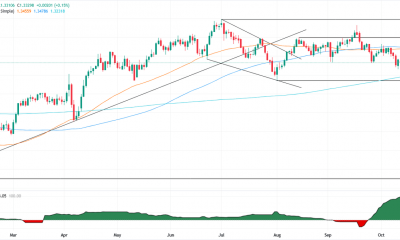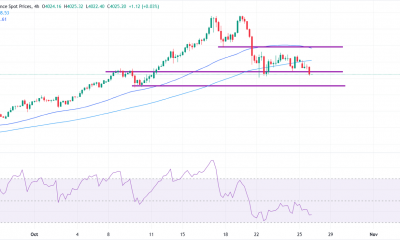

Metaverse
Many AI researchers think fakes will become undetectable – Crypto News
The video is fake. Generated with the help of AI, it is just one of 143 such advertisements catalogued by Fenimore Harper Communications, a British firm, which ran in December and January. It is not just those in the public eye who can have their likenesses used for dubious ends. In June 2023 the Federal Bureau of Investigation in America warned the public of “malicious actors” using AI to create fake sexually themed videos and images of ordinary people, in order to extort money.
How to detect such trickery is a live topic among AI researchers, many of whom attended NeurIPS, one of the field’s biggest conferences, held in New Orleans in December. A slew of firms, from startups to established tech giants such as Intel and Microsoft, offer software that aims to spot machine-generated media. The makers of big AI models, meanwhile, are searching for ways of “watermarking” their output so that real pictures, video or text can be readily distinguished from the machine-generated sort.
But such technologies have not, so far, proved reliable. The AI cognoscenti seem gloomy about their prospects. The Economist conducted a (deeply unscientific) straw poll of delegates to NeurIPS. Of 23 people asked, 17 thought AI-generated media would eventually become undetectable. Only one believed that reliable detection would be possible. (The other five demurred, preferring to wait and see.)
Detection software relies on the idea that AI models will leave a trace. Either they will fail to reproduce some aspect of real images and video, or of human-generated text, or they will add something superfluous—and will do so often enough to let other software spot the error. For a while, humans could do the job. Up until about the middle of 2023, for instance, image-generation algorithms would often produce people with malformed hands, or get the numbers wrong on things like clock faces. These days, the best no longer do.
But such telltales often still exist, even if they are becoming harder for humans to spot. Just as machines can be trained to reliably identify cats, or cancerous tumours on medical scans, they can also be trained to differentiate between real images and AI-generated ones.
It seems, though, that they cannot do so all that well. Detection software is prone to both false positives (wrongly flagging human content as generated by AI) and false negatives (allowing machine-generated stuff to pass undetected). A pre-print published in September by Zeyu Lu, a computer scientist at Shanghai Jiao Tong University, found that the best-performing program failed to correctly spot computer-generated images 13% of the time (though that was better than the humans, who erred in 39% of cases). Things are little better when it comes to text. One analysis, published in December in the International Journal of Educational Integrity, compared 14 tools and found that none achieved an accuracy of more than 80%.
If trying to spot computer-generated media after the fact is too tricky, another option is to label it in advance with a digital watermark. As with the paper sort, the idea is to add a distinguishing feature that is subtle enough not to compromise the quality of the text or image, but that is obvious to anyone who goes looking for it.
One technique for marking text was proposed by a team at the University of Maryland in July 2023, and added to by a team at University of California, Santa Barbara, who presented their tweaks at NeurIPS. The idea is to fiddle with a language model’s word preferences. First, the model randomly assigns a clutch of words it knows to a “green” group, and puts all the others in a “red” group. Then, when generating a given block of text, the algorithm loads the dice, raising the probability that it will plump for a green word instead of one of its red synonyms. Checking for watermarking involves comparing the proportion of green to red words—though since the technique is statistical, it is most reliable for longer chunks of writing.
Many methods for watermarking images, meanwhile, involve tweaking the pixels in subtle ways, such as shifting their colours. The alterations are too subtle for human observers to notice, but can be picked up by computers. But cropping an image, rotating it, or even blurring and then resharpening it can remove such marks.
Another group of researchers at NeurIPS presented a scheme called “Tree-Ring” watermarking that is designed to be more robust. Diffusion models, the most advanced type of image-generation software, begin by filling their digital canvas with random noise, out of which the required picture slowly emerges. The tree-ring method embeds the watermark not in the finished picture, but in the noise at the start. If the software that created a picture is run in reverse, it will reproduce the watermark along with the noise. Crucially, the technique is less easy to thwart by fiddling with the final image.
But it is probably not impossible. Watermarkers are in an arms race with other researchers aiming to defeat their techniques. Another team led by Hanlin Zhang, Benjamin Edelman and Boaz Barak, all of Harvard University, presented a method (not yet peer-reviewed) that can, they say, erase watermarks. It works by adding a dash of new noise, then using a second, different AI model to remove that noise, which removes the original watermark in the process. They claim to be able to foil three new text-watermarking schemes proposed in 2023. In September scientists at the University of Maryland published a paper (also not yet peer-reviewed) claiming that none of the current methods of image watermarking—Tree-Rings included—is foolproof.
Nevertheless, in July 2023 America’s government announced “voluntary commitments” with several AI firms, including OpenAI and Google, to boost investment in watermarking research. Having imperfect safeguards is certainly better than having none (although open-source models, which users are free to tweak, will be harder to police.) But in the battle between the fakers and the detectives, it seems that the fakers have the upper hand.
© 2023, The Economist Newspaper Limited. All rights reserved.
From The Economist, published under licence. The original content can be found on www.economist.com
-

 Technology6 days ago
Technology6 days agoSam Altman says OpenAI is developing a ‘legitimate AI researcher’ by 2028 that can discover new science on its own – Crypto News
-

 Blockchain1 week ago
Blockchain1 week agoISM Data Hints Bitcoin Cycle Could Last Longer Than Usual – Crypto News
-
others1 week ago
JPY soft and underperforming G10 in quiet trade – Scotiabank – Crypto News
-

 Blockchain1 week ago
Blockchain1 week agoXRP Price Gains Traction — Buyers Pile In Ahead Of Key Technical Breakout – Crypto News
-

 Technology1 week ago
Technology1 week agoNothing OS 4.0 Beta introduces pre-installed apps to Phone (3a) series: Co-founder Akis Evangelidis explains the update – Crypto News
-

 Technology1 week ago
Technology1 week agoMicrosoft ‘tricked users into pricier AI-linked 365 plans,’ says Australian watchdog; files lawsuit – Crypto News
-
Technology1 week ago
Ethereum Supercycle Strengthens as SharpLink Gaming Withdraws $78.3M in ETH – Crypto News
-

 De-fi6 days ago
De-fi6 days agoBittensor Rallies Ahead of First TAO Halving – Crypto News
-

 De-fi1 week ago
De-fi1 week agoNearly Half of US Retail Crypto Holders Haven’t Earned Yield: MoreMarkets – Crypto News
-

 Blockchain1 week ago
Blockchain1 week agoBig Iran Bank Goes Bankrupt, Affecting 42 Million Customers – Crypto News
-
others1 week ago
GBP/USD holds steady after UK data, US inflation fuels rate cut bets – Crypto News
-

 Blockchain1 week ago
Blockchain1 week agoKyrgyzstan Launches Stablecoin While Confirming Future CBDC – Crypto News
-
Business1 week ago
Crypto Market Rally: BTC, ETH, SOL, DOGE Jump 3-7% as US China Trade Talks Progress – Crypto News
-

 others1 week ago
others1 week agoGBP/USD floats around 1.3320 as softer US CPI reinforces Fed cut bets – Crypto News
-

 De-fi1 week ago
De-fi1 week agoAI Sector Rebounds as Agent Payment Systems Gain Traction – Crypto News
-
others1 week ago
Tether’s Stablecoin 1.0 Era Is Over – Now the Industry Needs 2.0 – Crypto News
-

 Cryptocurrency1 week ago
Cryptocurrency1 week agoBitcoin Accumulation Patterns Show Late-Stage Cycle Maturity, Not Definite End: CryptoQuant – Crypto News
-
others1 week ago
USD/JPY extends gains as strong US PMI offsets softer CPI data – Crypto News
-

 Cryptocurrency1 week ago
Cryptocurrency1 week agoCrypto wrap: Bitcoin, Ethereum, BNB, Solana, and XRP muted after CPI report – Crypto News
-

 Blockchain1 week ago
Blockchain1 week agoEthereum Rebounds From Bull Market Support: Can It Conquer The ‘Golden Pocket’ Next? – Crypto News
-

 De-fi1 week ago
De-fi1 week agoNearly Half of US Retail Crypto Holders Haven’t Earned Yield: MoreMarkets – Crypto News
-

 Cryptocurrency1 week ago
Cryptocurrency1 week agoWestern Union eyes stablecoin rails in pursuit of a ‘super app’ vision – Crypto News
-

 Blockchain1 week ago
Blockchain1 week agoBinance Stablecoin Outflow On A Steady Rise — What This Means For The Market – Crypto News
-
others1 week ago
Indian Court Declares XRP as Property in WazirX Hack Case – Crypto News
-

 De-fi1 week ago
De-fi1 week agoHYPE Jumps 10% as Robinhood Announces Spot Listing – Crypto News
-
others1 week ago
Platinum price recovers from setback – Commerzbank – Crypto News
-

 Blockchain1 week ago
Blockchain1 week agoIBM Set to Launch Platform for Managing Digital Assets – Crypto News
-
Business1 week ago
White House Crypto Czar Backs Michael Selig as ‘Excellent Choice’ To Lead CFTC – Crypto News
-
others1 week ago
Bitcoin Price Eyes $120K Ahead of FED’s 98.3% Likelihood to Cut Rates – Crypto News
-

 Technology1 week ago
Technology1 week agoMint Explainer | India’s draft AI rules and how they could affect creators, social media platforms – Crypto News
-

 Blockchain1 week ago
Blockchain1 week agoEntire Startup Lifecycle to Move Onchain – Crypto News
-

 De-fi1 week ago
De-fi1 week agoNearly Half of US Retail Crypto Holders Haven’t Earned Yield: MoreMarkets – Crypto News
-

 Blockchain1 week ago
Blockchain1 week agoXRP/BTC Retests 6-Year Breakout Trendline, Analyst Calls For Decoupling – Crypto News
-

 Cryptocurrency1 week ago
Cryptocurrency1 week agoUSDJPY Forecast: The Dollar’s Winning Streak Why New Highs Could Be At Hand – Crypto News
-
others1 week ago
Is Changpeng “CZ” Zhao Returning To Binance? Probably Not – Crypto News
-

 De-fi7 days ago
De-fi7 days agoTokenized Nasdaq Futures Enter Top 10 by Volume on Hyperliquid – Crypto News
-

 Cryptocurrency1 week ago
Cryptocurrency1 week agoNEAR’s inflation reduction vote fails pass threshold, but it may still be implemented – Crypto News
-

 Technology1 week ago
Technology1 week agoSurvival instinct? New study says some leading AI models won’t let themselves be shut down – Crypto News
-

 De-fi1 week ago
De-fi1 week agoMetaMask Fuels Airdrop Buzz With Token Claim Domain Registration – Crypto News
-

 Cryptocurrency7 days ago
Cryptocurrency7 days agoCitigroup and Coinbase partner to expand digital-asset payment capabilities – Crypto News
-

 Cryptocurrency6 days ago
Cryptocurrency6 days agoInside Bitwise’s milestone solana ETF launch – Crypto News
-

 Cryptocurrency6 days ago
Cryptocurrency6 days agoWhy Is Pi Network’s (PI) Price Up by Double Digits Today? – Crypto News
-

 De-fi1 week ago
De-fi1 week agoAave Labs Acquires Stable Finance to Expand DeFi Access – Crypto News
-
Technology1 week ago
James Wynn Takes XRP Long Bet After Ripple Prime Announcement – Crypto News
-

 others1 week ago
others1 week agoGold weakens as US-China trade optimism lifts risk sentiment, focus turns to Fed – Crypto News
-

 Cryptocurrency1 week ago
Cryptocurrency1 week agoGold Price Forecast 2025, 2030, 2040 & Investment Outlook – Crypto News
-

 De-fi7 days ago
De-fi7 days agoCRO Jumps After Trump’s Truth Social Announces Prediction Market Partnership with Crypto.Com – Crypto News
-

 Cryptocurrency7 days ago
Cryptocurrency7 days agoKERNEL price goes vertical on Upbit listing, hits $0.23 – Crypto News
-
Technology7 days ago
Breaking: $2.6B Western Union Announces Plans for Solana-Powered Stablecoin by 2026 – Crypto News
-

 Blockchain7 days ago
Blockchain7 days agoSolana Eyes $210 Before Its Next Major Move—Uptrend Or Fakeout Ahead? – Crypto News


















